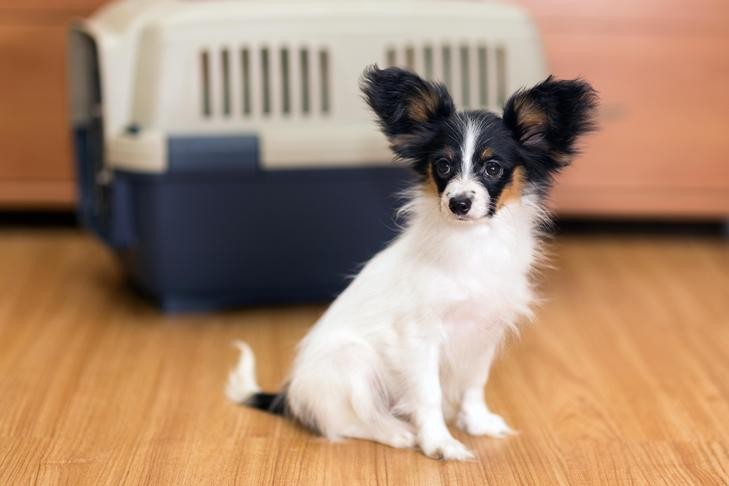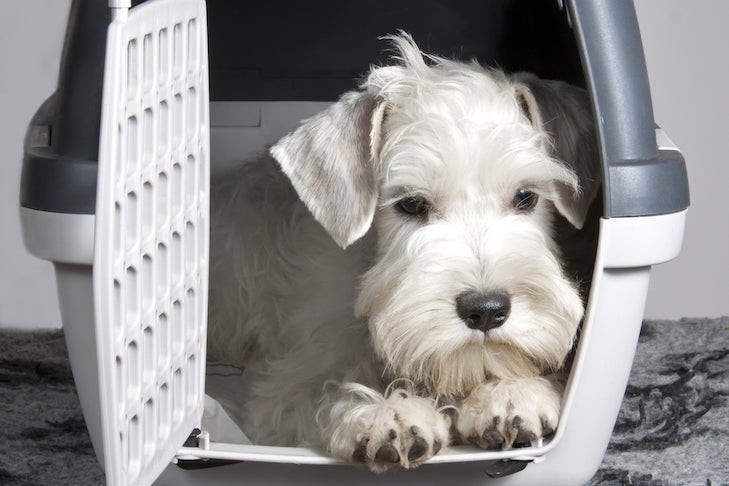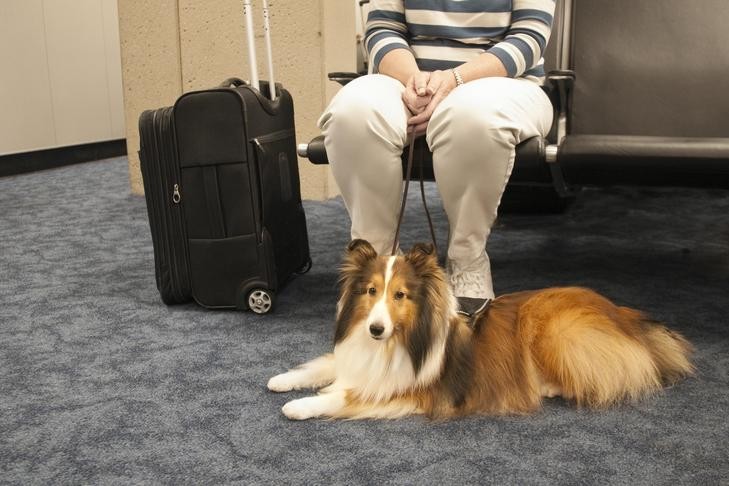Flying with your beloved canine companion can seem daunting, but with careful planning and preparation, it can be a smooth and even enjoyable experience for both of you. This guide provides a comprehensive overview of everything you need to know about How To Travel With A Dog By Plane, ensuring a safe and comfortable journey for your furry friend.
Is Air Travel Right for Your Dog?
Before you book that flight, consider whether air travel is the best option for your dog. As Dr. Jerry Klein, Chief Veterinary Officer of the American Kennel Club, points out, “Traveling by air can be stressful to people and to dogs.” The unfamiliar sounds, sights, and smells of airports and new environments can be overwhelming.
Furthermore, changes in diet and water can disrupt your dog’s digestive system. Time zone changes and the overall stress of travel can also lead to dehydration or disrupt medication schedules, especially for dogs with conditions like diabetes. Consult your veterinarian to determine if flying is safe and appropriate for your dog’s specific needs and health condition.
 Papillon in a Travel Crate
Papillon in a Travel Crate
Pre-Flight Preparations: A Step-by-Step Guide
Once you’ve decided that flying is feasible, thorough preparation is key.
Research and Regulations
- Destination Requirements: Verify that your dog is allowed to fly to your destination. Check for any quarantine restrictions, required vaccinations, or other specific regulations. The AKC provides a helpful list of state-by-state travel requirements, but remember to research international travel rules and regulations, especially for your return to the U.S.
- Airline Pet Policies: Contact the airline well in advance to understand their specific pet policies. Most airlines limit the number of dogs allowed in the cabin and have specific carrier size requirements. Some airlines also have breed restrictions.
- Book Direct Flights: Whenever possible, opt for direct flights to minimize stress and potential delays for your dog.
- Time of Year Considerations: If traveling during the summer, book early morning or late evening flights to avoid the hottest parts of the day. In winter, midday flights are preferable to avoid extreme cold. Note that some airlines may restrict pet travel in cargo during extreme temperatures.
- CDC Guidelines (for U.S. Entry): For dogs entering the U.S., familiarize yourself with the Centers for Disease Control and Prevention’s (CDC) latest guidelines. As of August 2024, these guidelines include submitting a CDC-approved Dog Import Form online in advance. Dogs must also be immunized against rabies, be at least 6 months old, and have a compliant microchip. Additional requirements may apply for dogs from “high-risk countries.”
Health and Veterinary Checklist
- Veterinary Check-up: Even if not required by the airline, schedule a check-up with your veterinarian. They can confirm your dog’s fitness for travel, ensure vaccinations are up-to-date, and provide an updated rabies certificate.
- Medications and Prescription Diets: Pack an ample supply of any prescription medications your dog needs, including preventative flea and tick treatments. If your dog requires a specialized diet, bring enough food for the entire trip, as it may not be readily available at your destination.
Essential Packing List for Your Canine Companion
Packing the right supplies will ensure your dog’s comfort and well-being during the journey.
- Vaccination and Health Records: Carry copies of your dog’s vaccination records and health certificate (if required).
- Airline-Approved Carrier: Select a carrier that meets the airline’s size requirements. The carrier should be waterproof and provide adequate space for your dog to stand, sit, lie down, and turn around comfortably.
- Food and Water Bowls: Pack portable food and water bowls for easy access during layovers or delays.
- Food and Treats: Carry a sufficient amount of your dog’s regular food and some treats for positive reinforcement.
- Poop Bags and Pet Wipes: Be prepared for accidents with poop bags and pet wipes for quick and easy cleanup.
- Chew Toy: A chew toy can help alleviate stress and discomfort during takeoff and landing.
Preparing Your Dog Mentally and Physically
Acclimating your dog to the travel experience is crucial for a smooth journey.
Crate Training
- Early Exposure: Introduce your dog to their crate well in advance of the trip. Make the crate a positive space by associating it with praise and treats.
- Familiarization: Encourage your dog to spend time in the crate at home, so they become comfortable with being confined for extended periods.
Airport Acclimation
- Exposure to Crowds and Noise: Take your dog to busy, dog-friendly locations like bus stations or pet stores to desensitize them to the sights and sounds of an airport.
- Behavioral Training: Ensure your dog is well-behaved and can follow basic commands. Airlines require that dogs be non-disruptive and not exhibit excessive barking, growling, or aggressive behavior.
- Canine Good Citizen (CGC) Training: Consider training your dog for the AKC’s CGC title. The skills learned, such as walking politely through a crowd, will be beneficial in an airport environment.
- Simulated Airplane Environment: Some dog trainers offer specialized training programs that simulate an airplane environment, teaching dogs how to behave in a carrier under a seat.
Navigating the Airport with Your Dog
Check-in Procedures
- Cargo Travel: If your dog is traveling in cargo, check them in with the airline upon arrival at the airport. Airline staff will then be responsible for your dog’s care and transport onto the plane.
- Cabin Travel: If your dog is traveling in the cabin, proceed through TSA security. You will need to remove your dog from their carrier for security screening. Your dog will either walk through the full-body scanner with you or be walked around it while you go through. TSA personnel will also screen the carrier and may inspect your dog’s collar, harness, and leash.
Pet Relief Areas
- Designated Areas: Most airports offer designated pet relief areas where your dog can relieve themselves. Make sure to take advantage of these facilities before your flight.
- Pre-Flight Exercise: Allow your dog some time outside of their carrier to stretch their legs before boarding (if permitted by the airport).
 Sealyham Terrier in a Travel Crate
Sealyham Terrier in a Travel Crate
Onboard the Plane: Ensuring a Smooth Flight
- Carrier Placement: During the flight, your dog must remain inside their carrier. They are not allowed to sit on your lap or roam freely in the cabin.
- Comfort and Reassurance: Provide your dog with a chew toy or familiar blanket to help them relax.
- Managing Pressure Changes: Chewing can help alleviate discomfort during takeoff and landing by helping your dog adjust to pressure changes.
Airline-Specific Guidelines: A Quick Reference
Below is a summary of pet policies for some of the most common airlines in the U.S. Remember to always verify the most up-to-date information with the airline directly before booking.
- Alaska Airlines: Allows dogs in both the cabin and cargo (with restrictions). Fee: $100 per pet.
- American Airlines: Allows dogs in the cabin (on flights up to 11.5 hours) and in cargo only for active-duty US Military and US State Department personnel. Fee: $150 per carrier in the cabin.
- Delta: Allows dogs in both the cabin and cargo. Fee: $95 each way for domestic flights, $200 for international flights.
- Frontier: Allows dogs in the cabin on domestic flights and flights to/from the Dominican Republic and Mexico. No cargo transport. Fee: $99 each way.
- Hawaiian Airlines: Allows dogs in the cabin (on interisland and mainland-Hawaii flights) and in cargo (with restrictions). Fee: $35 for flights within Hawaii, $125 for flights between Hawaii and the mainland.
- JetBlue: Allows dogs under 20 pounds in the cabin. No cargo transport. Fee: $125 per flight.
- Southwest Airlines: Allows dogs in the cabin on domestic flights only. No cargo transport. Fee: $125 per pet carrier for US Mainland flights, $35 per pet carrier between Hawaiian Islands.
- Spirit: Allows dogs in the cabin on domestic flights only. No cargo transport. Fee: $125 per flight.
- United: Allows dogs in the cabin on domestic and international flights (age restrictions apply). No cargo transport. Fee: $125 per flight, with additional fees for long layovers.
 Shetland Sheepdog service dog at the airport
Shetland Sheepdog service dog at the airport
Conclusion
Traveling with a dog by plane requires careful planning and preparation, but it’s certainly achievable. By following these guidelines, consulting with your veterinarian, and understanding the specific requirements of your chosen airline, you can ensure a safe and comfortable journey for your beloved furry friend. Remember to prioritize your dog’s well-being throughout the entire process, and enjoy your travels together!

